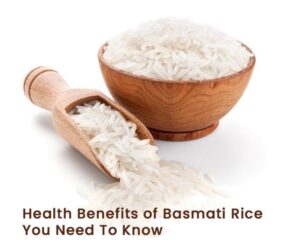By Prof. Raphael Nyarkotey OBU
Diabetics are more particular about the type of food they eat. This is because the type of food can either increase or decrease their blood sugar content. Rice has been a subject of controversy for diabetics.

However, others believe that not all types of rice are equal and some types are diabetic-friendly. This is because white rice has a glycemic index of 89. Hence, I examine the science behind Basmati rice on our health in this article.
Nutrition facts
The nutritional value of Basmati rice varies depending on the type one buys. However, in the generic terms, each type is high in carbs and calories, as well as micronutrients like folate, thiamine and selenium.
The US Department of Agriculture states that: One cup (163 grams) of cooked white basmati rice contains the following:
- Calories: 210
- Protein: 4.4 grams
- Fat: 0.5 grams
- Carbs: 45.6 grams
- Fibre: 0.7 grams
- Sodium: 399 mg
- Folate: 24% of the Daily Value (DV)
- Thiamine: 22% of the DV
- Selenium: 22% of the DV
- Niacin: 15% of the DV
- Copper: 12% of the DV
- Iron: 11% of the DV
- Vitamin B6: 9% of the DV
- Zinc: 7% of the DV
- Phosphorus: 6% of the DV
- Magnesium: 5% of the DV
The same organisation further held that brown Basmati rice is somewhat higher in calories, carbs, and fibre. Furthermore, the magnesium, vitamin E, zinc, potassium and phosphorus are more as compared to white Basmati rice.
Basmati: scientific justification
Some types are whole grains
Brown Basmati rice is regarded a whole grain. This means that it contains all three parts of the kernel — the germ, bran and endosperm. Why are whole grains good for our health? One study happens to answer this: Aune et al. (2016) analysed 45 studies and found that whole grain consumption decreases one’s risk of heart disease, cancer and premature death.
A previous review by Aune et al. (2013) also reported that consumption of whole grains, including brown rice, reduces ones risk of type 2 diabetes. What is more interesting is that one randomised controlled trial, Vitaglione et al.(2015), examined 80 respondents in an 8-week study and found that substituting refined grains with whole grains decreased ones levels of inflammatory markers.
Basmati, supplemented
It is believe that the white Basmati rice is mostly supplemented to improve some nutrients that were lost in the processing stages to enhance the nutritional value. This is done to improve our vitamins and mineral content. Rice and other grains are regularly augmented with iron and B vitamins like folic acid, thiamine and niacin.
Basmati, arsenic
Hong et al. (2014) study found that basmati is normally lower in arsenic, a heavy metal that could destroy our health and, in turn, reduces the risk of diabetes, heart problems and some cancers – juxtaposed to other types of rice. Also, arsenic accrues a lot in rice as compared to other grains. This raises many health issues for frequent consumers of white rice. But the good news is that, Basmati rice from California, India or Pakistan have the lowest levels of arsenic, juxtaposed to other rice varieties (Davis et al. 2017). Also, Basmati brown rice types have higher levels of arsenic than white rice, as it accrues in the hard outer bran layer.
Basmati, warnings
White Basmati is a refined grain, unlike the brown Basmati; this affects the nutritional content. Two meta-analysis (Musa-Veloso et al. 2018; Hu et al. 2012) found that the eating refined grains could negatively affect blood sugar and potentially increases the risk of type 2 diabetes. Another study, Kim et al.(2012), examined over 10,000 people and found that eating more white rice increases the risk of obesity.
Furthermore, Ahn et al. (2013) examined 26,006 people and found a link between white rice intake and a higher risk of metabolic syndrome, a group of conditions that can increase your risk of heart disease, stroke and type 2 diabetes. This could be due to white rice’s high amount of carbs and low amount of fibre compared with brown rice. This means although white Basmati rice can be eaten in moderation, brown Basmati may be a better overall option for your health.
Take home
From the review, is Basmati diabetic-friendly? It appears so. According to the Canadian Diabetes Association, Basmati, brown, wild, short and long grain types of rice have a medium glycemic index (between 56 and 69), as opposed to jasmine and instant white rice with a glycemic index of 89; thus, making it more suitable for diabetics as compared to certain other grains and products made from white flour. Besides, it also has many health benefits from studies.
NB: Prof. Nyarkotey has strict sourcing guidelines and relies on peer-reviewed studies, academic research institutions and medical associations to justify his write-ups. My articles are for educational purposes and do not serve as medical advice for treatment. I aim to educate the public about evidence-based scientific naturopathic therapies.
The writer is a Professor of Naturopathic Healthcare, a Medical Journalist and a science writer. He is also President, Nyarkotey College of Holistic Medicine & Technology (NUCHMT)/African Naturopathic Foundation, Ashaiman, Ghana. Currently a BL Candidate at the Gambia Law School, Banjul.
Email: [email protected].
References
- Ahn Y, Park SJ, Kwack HK, Kim MK, Ko KP, Kim SS. Rice-eating pattern and the risk of metabolic syndrome especially waist circumference in Korean Genome and Epidemiology Study (KoGES). BMC Public Health. 2013 Jan 22;13:61. doi: 10.1186/1471-2458-13-61. PMID: 23339671; PMCID: PMC3680034.
- “The Glycemic Index”. Canadian Diabetes Association. Retrieved 30 August 2018.
- Kim J, Jo I, Joung H. A rice-based traditional dietary pattern is associated with obesity in Korean adults. J Acad Nutr Diet. 2012 Feb;112(2):246-53. doi: 10.1016/j.jada.2011.10.005. Epub 2012 Jan 25. PMID: 22732459.
- Hu EA, Pan A, Malik V, Sun Q. White rice consumption and risk of type 2 diabetes: meta-analysis and systematic review. BMJ. 2012 Mar 15;344:e1454. doi: 10.1136/bmj.e1454. PMID: 22422870; PMCID: PMC3307808.
- Musa-Veloso K, Poon T, Harkness LS, O’Shea M, Chu Y. The effects of whole-grain compared with refined wheat, rice, and rye on the postprandial blood glucose response: a systematic review and meta-analysis of randomized controlled trials. Am J Clin Nutr. 2018 Oct 1;108(4):759-774. doi: 10.1093/ajcn/nqy112. PMID: 30321274.
- Hong YS, Song KH, Chung JY. Health effects of chronic arsenic exposure. J Prev Med Public Health. 2014 Sep;47(5):245-52. doi: 10.3961/jpmph.14.035. Epub 2014 Sep 11. PMID: 25284195; PMCID: PMC4186552.
- Aune D, Keum N, Giovannucci E, Fadnes LT, Boffetta P, Greenwood DC, Tonstad S, Vatten LJ, Riboli E, Norat T. Whole grain consumption and risk of cardiovascular disease, cancer, and all cause and cause specific mortality: systematic review and dose-response meta-analysis of prospective studies. BMJ. 2016 Jun 14;353:i2716. doi: 10.1136/bmj.i2716. PMID: 27301975; PMCID: PMC4908315.
- Aune D, Norat T, Romundstad P, Vatten LJ. Whole grain and refined grain consumption and the risk of type 2 diabetes: a systematic review and dose-response meta-analysis of cohort studies. Eur J Epidemiol. 2013 Nov;28(11):845-58. doi: 10.1007/s10654-013-9852-5. Epub 2013 Oct 25. PMID: 24158434.
- Vitaglione P, Mennella I, Ferracane R, Rivellese AA, Giacco R, Ercolini D, Gibbons SM, La Storia A, Gilbert JA, Jonnalagadda S, Thielecke F, Gallo MA, Scalfi L, Fogliano V. Whole-grain wheat consumption reduces inflammation in a randomized controlled trial on overweight and obese subjects with unhealthy dietary and lifestyle behaviors: role of polyphenols bound to cereal dietary fiber. Am J Clin Nutr. 2015 Feb;101(2):251-61. doi: 10.3945/ajcn.114.088120. Epub 2014 Dec 3. PMID: 25646321.
- Last accessed at 24 January 2023, https://en.wikipedia.org/wiki/Basmati










